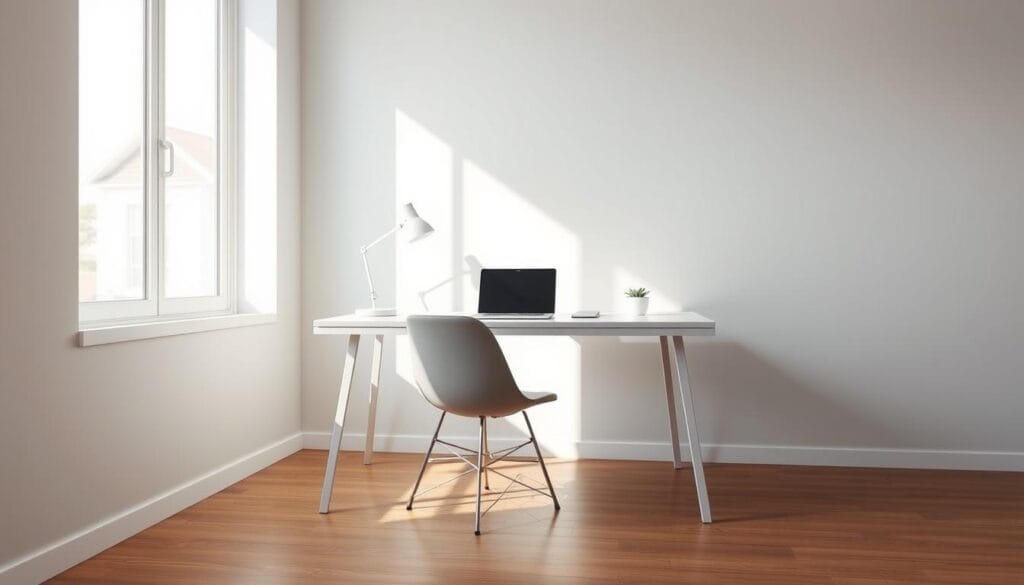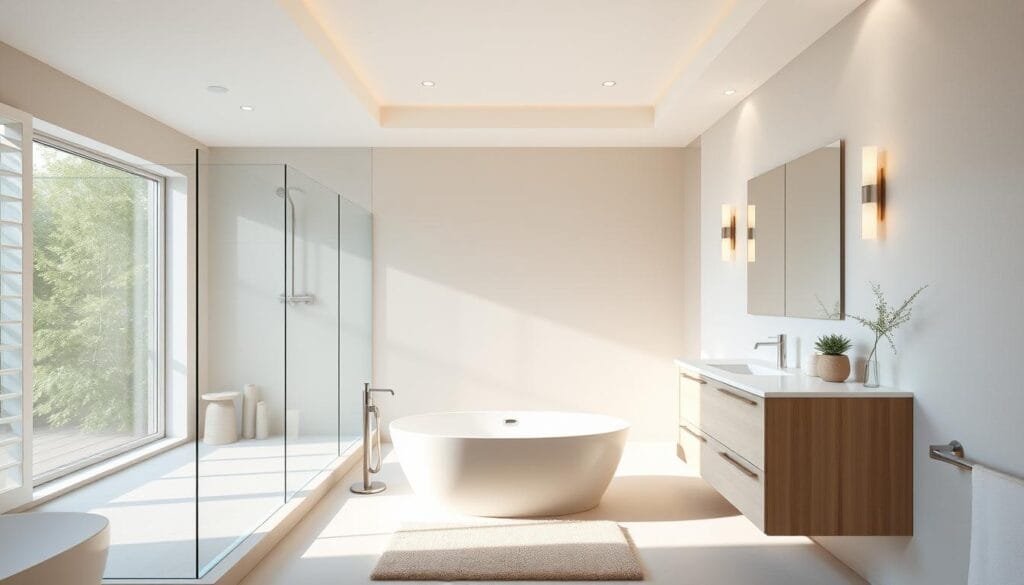Imagine walking into your home after a long day. You’re greeted by open spaces, clean lines, and tranquility right away. 🌿✨ Welcome to minimalist house design.
Minimalist homes draw inspiration from Scandinavian simplicity. They offer beauty and calm. From cozy cabins to large villas, every space uses natural light and focuses on what’s essential. Rooms turn into sanctuaries, with natural wood and a neat look.
The charm of minimalist decor has shown itself in many places. From Scandinavian textures to urban lofts, the approach shows how less becomes more. Consider a living room with just a few key furniture pieces. Or a bedroom with only essential items. The result is visually stunning and deeply calming.
In modern minimalist architecture, quality beats quantity. Choosing a few high-quality items makes a space not only look better but also easier to keep clean. Less clutter means less stress and more peace.
If you’re considering this lifestyle, know it’s about finding peace and purpose. Explore minimalist homes to inspire your own calm sanctuary.
Understanding Minimalist House Design
Minimalist house design combines simplicity with elegance. It sticks to “less is more.” This style got popular in the 1960s and 1970s. It attracts people who want peace in their homes.
Definition of Minimalism
Minimalism means keeping only what’s necessary. It makes sure everything has a purpose. It often uses open plans and simple colors. The aim is to make spaces feel open and tidy.
“Less is more” comes from architect Ludwig Mies van der Rohe. Minimalism fights against buying too much. It supports sustainability. It turns homes into calm, useful places.
Key Characteristics of Minimalist Design
Minimalist house plans are easy to recognize. They focus on simplicity and efficiency. Homes often look straightforward and clean. Key features include:
- Simple Lines: Designs have clean lines for doors and windows.
- Neutral Color Palettes: They use simple colors to keep spaces fresh.
- Natural Materials: Concrete and glass are common, for a consistent look.
- Open Floor Plans: Fewer walls and smart storage increase light and views.
Minimalist designs create calm and clear spaces. They make sure everything has a reason to be there. This design can make life less stressful and more efficient. It’s a great choice for today’s homes.
Benefits of a Minimalist House
Choosing a minimalist house design brings many upsides. It makes our spaces look good and work better. By having a clean home, we get to enjoy the good things about living simply. This makes our daily lives smoother and nicer. Check out these minimalist lifestyle benefits.
Enhanced Functionality
Minimalism makes our homes work better. Open floor plans, a big feature of this style, save up to 30% on lighting energy. Plus, it cuts cleaning time by about 40% because there’s less stuff to clean. Everything has its place, making it easy to move and live efficiently.
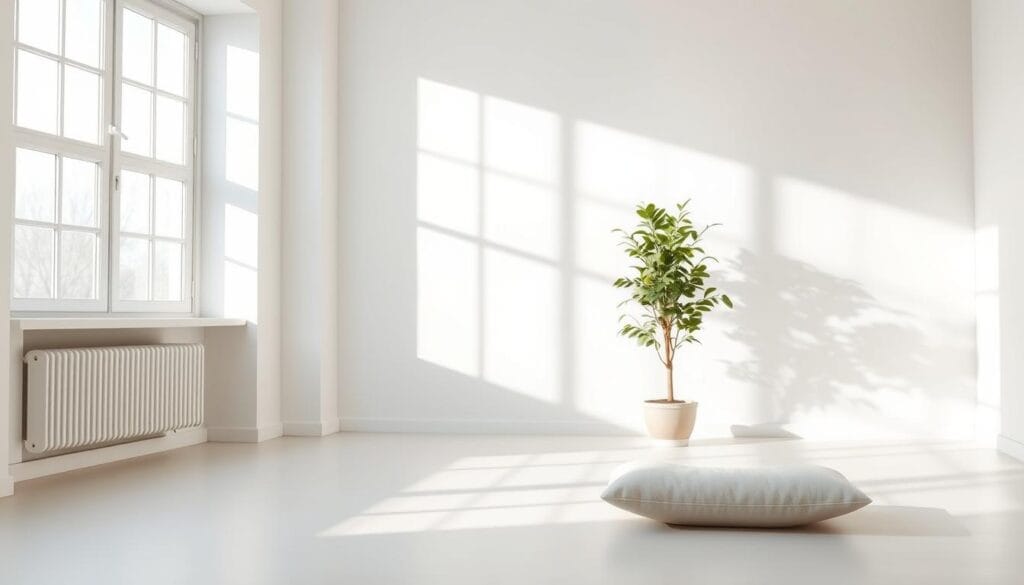
Stress Reduction and Mindfulness
One top perk of living minimally is less stress. Clutter can make us feel stressed out. But, a minimalist home gives us a calm space that helps with mindfulness. 70% of people feel more relaxed in such spaces. Plus, it helps us think clearer and focus on what matters.
This way of living makes us careful about what we buy, saving money and helping the planet. We focus on fixing and reusing things instead of always buying new. This gives us a nicer life at home, making every moment more special and happy.
Core Principles of Minimalist Design
Embracing minimalist design focuses on space, light, simple lines, and natural materials. It creates a calm, clutter-free living space. This lets you concentrate on what’s important.
Space and Light
Minimalist design uses space and light smartly. It makes homes feel larger and more welcoming. For instance, using tall cabinets in kitchens adds storage without clutter.
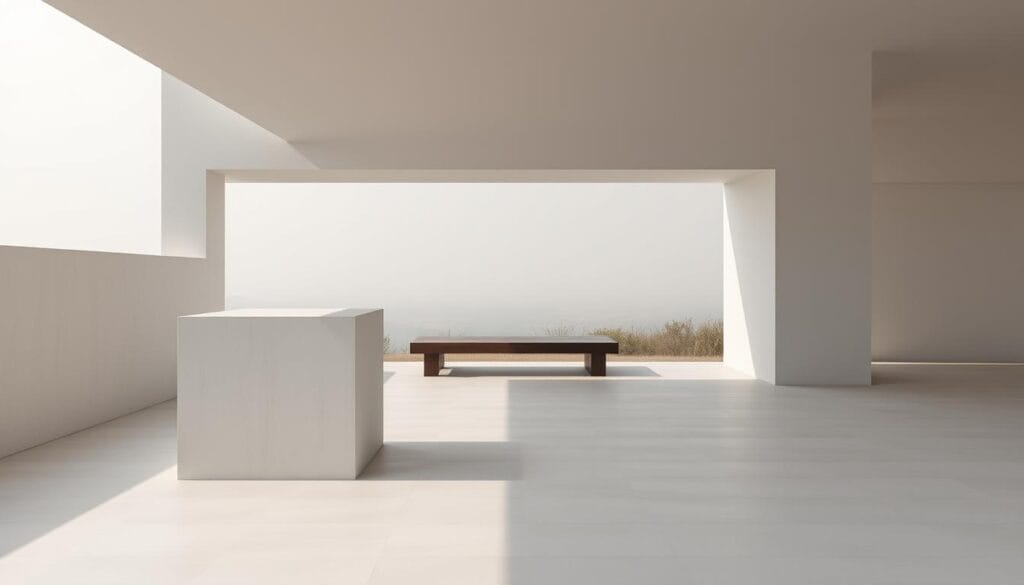
Simplicity Over Complexity
In minimalist designs, simplicity is key. It’s about keeping only what you need and favoring clean designs. “Less is more” helps us live with less clutter and feel more at peace.
The Importance of Natural Materials
Natural materials are vital in minimalist design. Adding wood and stone brings warmth and authenticity. It’s not just beautiful; it’s also good for the planet.
Popular Minimalist Design Styles
The world of minimalist design is wide and diverse. It offers a variety of styles, each with its unique appeal and usefulness. You can find everything from the cozy Scandinavian design to the serene Japanese architecture, and the bold industrial minimalism. There’s a minimalist style for everyone, fitting different tastes and cultural backgrounds.
Scandinavian Minimalism
Scandinavian design aims to fill homes with light, blending functionality with a breezy feel. It’s known for its bright rooms filled with natural light, loved by many enthusiasts. White walls are key in this style, making rooms look more spacious. By using light woods and natural fabrics like wool and linen, Scandinavian interiors are warm and welcoming. They combine simplicity with comfort. IKEA’s simple cabinet designs are a big hit in minimalist kitchens because of this look.
Japanese Zen Design
Japanese minimalist architecture is deeply rooted in Zen philosophy. It focuses on creating tranquil and mindful spaces. About 25% of minimalism fans are drawn to this style. It favors natural materials and uncluttered spaces for peace. Features like tatami mats, sliding doors, and blending indoor with outdoor spaces are common. This approach uses soft colors to enhance a calm, thoughtful vibe.

Industrial Minimalism
Industrial minimalism is known for its rough, practical elements. It attracts about 20% of people interested in minimalist design. The style includes exposed bricks, steel beams, and concrete, giving a strong look. These areas often have open layouts and tall ceilings, making them feel spacious. Mixing tough textures with modern furniture creates a polished, edgy home.
Scandinavian, Japanese Zen, and Industrial styles all follow minimalist design’s main ideas. They focus on being functional, simple, and close to nature. More people have started loving these styles in the last five years. Homeowners are choosing minimalist techniques to create elegant, peaceful homes.
Essential Elements of Minimalist House Design
Embracing minimalist interior design is all about its key features. It’s from the open space plans to simple lines and geometric shapes that we find out what makes this style unique.
Open Floor Plans
Open-concept living is vital for a feeling of space. Around 70% of minimalist houses use open layouts for better space feel. This design invites freedom and boosts home connection.
By avoiding extra walls, we get a space that’s both useful and nice to look at.
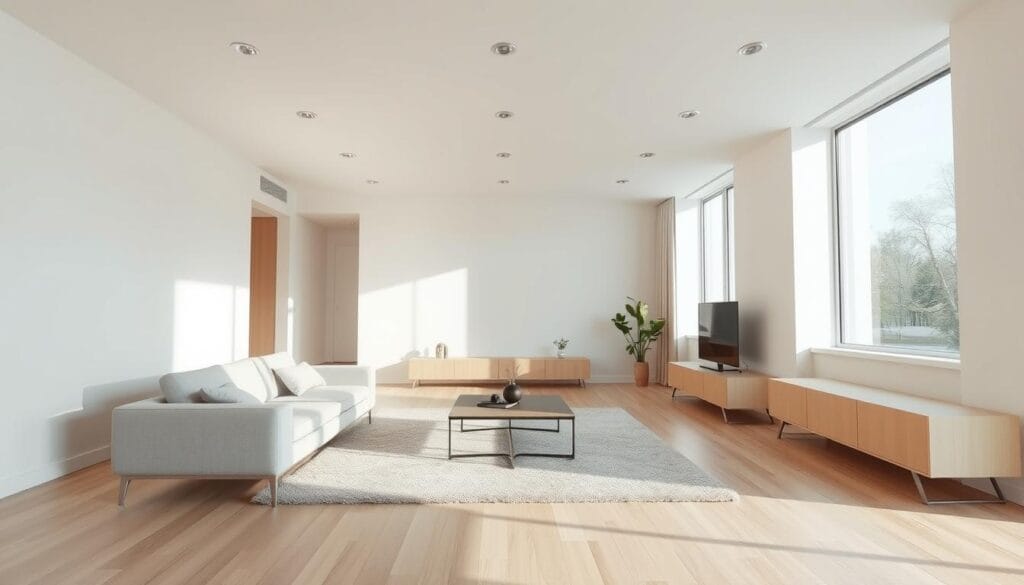
Neutral Color Palettes
Neutral colors like whites, beiges, greys, and blacks fill 85% of minimalist spaces. These colors offer a calm feel, making it easier to think and lower stress. Adding natural light could make you feel and work better by up to 20%.
Clean Lines and Geometric Forms
Geometric shapes and simple lines are at the heart of minimalist style. These features create a neat, organized look that’s free from clutter. About 60% of minimalist places have built-in storage to keep things tidy.
Materials such as wood, glass, and stone are used in 75% of minimalist projects, adding to the sleek look.
Choosing Furniture for Minimalist Spaces
Picking the right furniture for your minimalist space is key to a chic, functional home. Minimalist furniture design helps you make the most out of both looks and use. Let’s look at how multi-functional furniture, empty spaces, and matching colors can make your place better.
Multi-Functional Furniture
Using multi-functional furniture is a top idea for minimalist areas. Imagine a sofa bed that you can fold in four ways. It saves space and serves several purposes. Aim for timeless, high-quality items that fit well with the minimalist “less is more” rule.
The Role of Negative Space
Negative space is vital in minimalist design. It’s not just about adding things, but also about what you don’t add. Open spaces let the eye rest, making rooms look bigger and more peaceful. For example, hidden storage like storage ottomans keeps the place tidy and sleek. It subtly boosts your minimalist style and keeps everything organized.
Color Coordination Tips
Getting color harmony in design right is crucial for a cohesive minimalist look. Stick to neutral colors like whites, beiges, and grays as your base. These colors bring calm and unity to your space. Choosing furniture in these shades helps keep your home’s look seamless. This approach makes the place feel planned and calm.
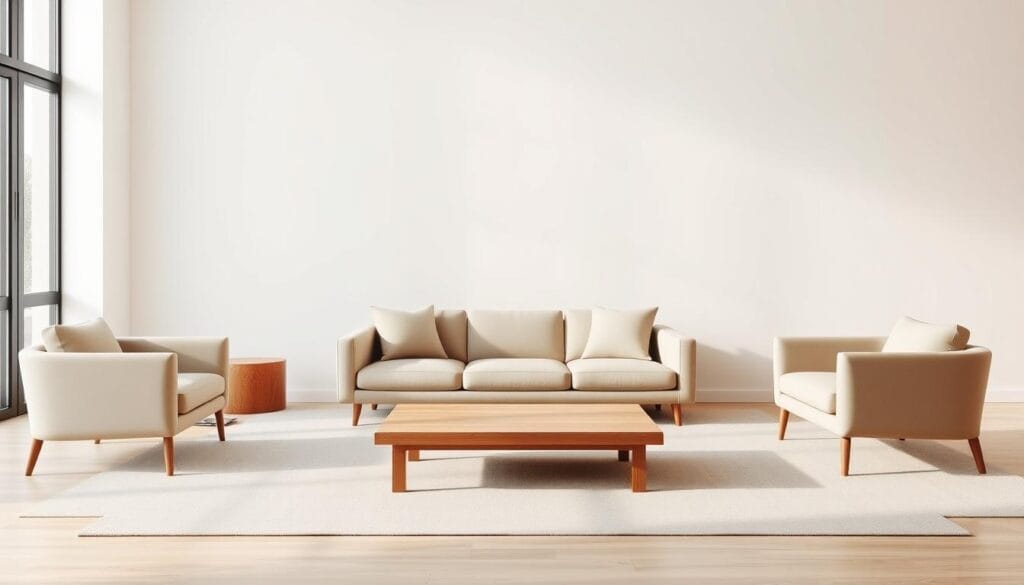
Minimalist living aims to reduce clutter and make your space feel open and welcoming. Focus on minimalist furniture design, use negative space wisely, and choose colors thoughtfully. These steps will help turn your home into a calm haven.
Incorporating Nature into Minimalist Design
Adding natural elements to minimalist garden design brings peace and balance to our spaces. We can do this by including indoor plants, making the most of natural light, and blending indoor with outdoor living. This approach improves both the beauty and use of our homes.
Indoor Plants
Adding plants to your minimalist area is pretty and good for health. The University of Exeter found plants can make us 15% more creative and productive. They also clean the air by taking in carbon dioxide and giving out oxygen. A few carefully picked plants add nature’s touch while keeping design simple.
Bringing the Outdoors In
Indoor-outdoor living means having a smooth flow between inside and outside areas. Large windows, glass doors, and mirrors help blend these spaces. They bring in more light and connect us to the outdoors. Using colors like beige, brown, and green makes homes feel more peaceful and fits the minimalist style.
Natural Light Maximization
Good minimalist design relies heavily on natural light. Big windows and skylights let in lots of sunlight, making spaces feel open and fresh. Studies show natural light lowers stress, boosts mood, and increases productivity. Making the most of sunlight also saves energy, keeping with minimalist values of simplicity and eco-friendliness.
To wrap up, blending nature into minimalist design through plants, combining indoor-outdoor living, and using natural light creates a balanced, green living space. These steps enhance how a home looks and feels. They also support wellness, showing the true spirit of minimalist gardening and design.
Sustainable Practices in Minimalist Design
Embracing sustainability in minimalist design means making smart choices for our planet and homes. By adding sustainable practices to our homes, we create a balance between nature and simplicity. This balance improves minimalist living.
Eco-Friendly Materials
Choosing sustainable materials for our homes has a big impact. By using eco-friendly materials like reclaimed wood, bamboo, and recycled glass, we lessen our environmental impact. These materials are durable and help reduce the use of natural resources.
Reclaimed wood adds unique beauty to tables or shelves while saving new lumber. Using local and recycled materials also cuts down on emissions from transportation. It helps support a more sustainable world.
Energy Efficiency Considerations
For a minimalist home, being energy-efficient is key. Having proper insulation and sealing leaks can cut down energy loss. Putting windows facing south lets in more light, which saves on heating costs in cold places.
Choosing appliances and lights that use less energy also helps. This includes Energy Star-certified products and LED lighting. Adding solar panels reduces the use of non-renewable energy, making homes more eco-friendly.
Waste Reduction Techniques
Reducing waste is important in sustainable home design. Using long-lasting materials means our homes need fewer repairs or replacements. This lowers waste.
Choosing native plants for our yards saves water and cuts down on upkeep. Collecting rainwater for use in gardens or toilets also saves water. Having furniture that serves multiple purposes keeps our homes clutter-free and aligned with minimalist values.
Minimalist Design for Small Spaces
Designing small minimalist apartments can seem tough, but it’s really a chance to make a comfy home that’s super functional. By using smart ideas for small spaces, anyone can turn their place into a chic and efficient home.
Creative Storage Solutions
With limited space, storage needs to be clever. Built-in shelves or storage under the bed keeps things tidy and looks good too. Using ottoman beds or coffee tables with hidden storage helps save space and keeps your design smooth.
Folding and Expandable Furniture
For small minimalist apartments, folding and expandable furniture is a must-have. Wall-mounted desks or extendable dining tables make the most of every inch. These items are not only super practical but also keep your place looking stylish.
Maximizing Vertical Space
Using vertical space is great for small areas. Put up shelves that go all the way to the ceiling to save floor space. Adding hanging plants or cool wall art can make the room seem bigger. And painting the ceiling light or using big mirrors makes the space feel airy and open.
| Design Element | Space-Saving Benefit | Implementation Tips |
|---|---|---|
| Built-In Shelving | Increases storage without occupying floor space | Install above desks or along empty walls to declutter surfaces. |
| Folding Furniture | Provides flexibility in usage | Opt for wall-mounted desks or tables that can be stowed away. |
| Vertical Storage | Utilizes wall space efficiently | Use tall shelves or hanging plants to draw the eye upwards. |
| Mirror Placement | Enhances perception of space | Place large mirrors opposite windows to reflect light. |
Minimalist design makes small spaces more than just useful—it changes them completely. With smart storage and furniture that has more than one use, even the tiniest apartment becomes an organized, cool place to live. Let’s use these ideas to make our homes feel bigger and brighter.
Challenges of Minimalist House Design
The rise in minimalist lifestyle popularity is clear, with a 60% increase in searches for minimalist home decor over five years. But mastering minimalist challenges takes more than clearing space. In this piece, we’ll uncover how to keep your minimalist home in balance, embracing the ease of a simple life.
Overcoming Clutter Challenges
Dealing with clutter is a huge issue in minimalist living. We often keep things we think we need but hardly use. Studies indicate that 68% of people find a clutter-free space boosts their focus and concentration. To beat this, regularly clear out clutter and be thoughtful about what you bring home. Using smart storage and believing in less is more can cut down your belongings by half, making your space work better.
Balancing Aesthetics and Comfort
Adopting minimalist living means embracing simple designs, which can feel uninviting. In fact, 60% believe minimalist areas are too impersonal and cold. Adding textures like cozy blankets and smart lighting makes minimalist rooms warmer. Impressively, 70% of designers suggest this method to soften minimalist spaces’ harsh feel.
Personalization Without Excess
It can be hard to make a minimalist space truly feel like your own without adding too much. The essence of minimalism is about being practical yet simple. But adding a bit of you is key. About 45% of minimalism fans value eco-friendly items for a unique touch. Decorate with meaningful pieces, like simple family photos or art, to express yourself within a minimalist framework.
A minimalist home needs constant care but offers more function, less stress, and peace. Despite its challenges, embracing minimalism can enrich your life, making your home more enjoyable and aesthetically pleasing.
Examples of Successful Minimalist Homes
When we look at minimalist homes, we find simplicity and beauty. Famous minimalist architects show us how less can be more in modern buildings. We will focus on two examples that highlight the beauty of minimalist design.
Case Study: The Mies van der Rohe Farnsworth House
The Farnsworth House is a key example of minimalist design. It’s in Plano, Illinois, and shows the “less is more” idea in action. The house was built between 1945 and 1951 by Ludwig Mies van der Rohe.
This house has an open floor plan and walls made of glass from top to bottom. This design creates a connection with nature. Mies van der Rohe’s use of steel and glass also makes the structure of the building stand out.
Case Study: Tadao Ando’s Church of the Light
Tadao Ando designed the Church of the Light in Japan, finished in 1989. It shows how minimalist design can add meaning to places for prayer and community. The design is simple but full of emotion and beauty.
Ando used concrete walls and a cross of light for a calm, thoughtful space. This church is one of his most famous works. It highlights how he mixes natural elements and architecture, showing the strength of minimalist design.
The Farnsworth House and the Church of the Light both show the lasting charm of minimalist design. These examples teach us about combining simplicity, function, and beauty. They are inspired by great architects like Mies van der Rohe and Tadao Ando. Following their ideas can help us design spaces that are both lovely and meaningful.
Tips for Transitioning to Minimalist Living
Minimalist living is more than just cleaning out your home. It’s a complete change in how you see things. By learning how to declutter, buy mindfully, and keep a minimalist mindset, you make your life better and more meaningful.
Decluttering Your Home
First, decluttering your home is a big step. A tidy space makes your mind clear and boosts creativity. It makes you relax and feel less stressed. Did you know 90% of our stuff isn’t needed? It holds us back from feeling free and happy.
Start by tackling each room one by one. Decide what you really need. Take small steps so it’s not too much at once.
Mindful Purchasing Habits
Mindful buying is key to staying minimalist. Ask yourself if an item is really needed or makes you happy before buying it. Fewer things in the house mean stronger family bonds and less fighting about cleaning.
Choosing wisely what comes into your home also means more free time. You’ll have less cleaning to do and feel more at peace.
Creating a Minimalist Mindset
Last, having a minimalist mindset helps keep this lifestyle going. It’s all about liking quality more than quantity and enjoying simple pleasures.
During the pandemic, 71% of Americans worked from home, up from 20%. We now stay indoors 23 hours a day. This shows how important a calm and purposeful living space is. In minimalist homes, every item should have a purpose or make you happy.


